From the Christian celebration to elements of Yule and images drawn from advertising art, literature, and more, the idea of Christmas in America comes loaded with its own set of stories and symbols. However, one bit of lore that hasn’t quite made the transition to the States is the existence of an entire class of Christmas monsters. That’s right; to you, it might just mean Santa and elves and reindeer, but in many other countries, Christmastime means Monster Time. Here’s a bestiary of beings that lurk in the silent night.
1. The Krampus
The trailer for Krampus (2015) (Uploaded to YouTube by Legendary)
The Krampus has become the king of the Christmas monsters. He’s broken in America in a big way in the last couple of decades, notably with comics and a handful of horror films. A counterpart to Santa who punishes bad children, Krampus has his roots in the eight Alpine countries (Germany, Austria, Italy, etc.) stretching back to at least the 1500s. Represented as a demonic humanoid with goat horns (recalling the pagan “Horned God”) and cloven feet, Krampus frequently carries chains, bells, and branches (which are used to whip the bad kids). Krampusnacht, December 5, is the night before the Feast of St. Nicholas; this is recognized in a number of European communities with activities like parades. “Krampus Walks,” featuring attendees in costume, are becoming more popular in the U.S.
2. Knecht Ruprecht
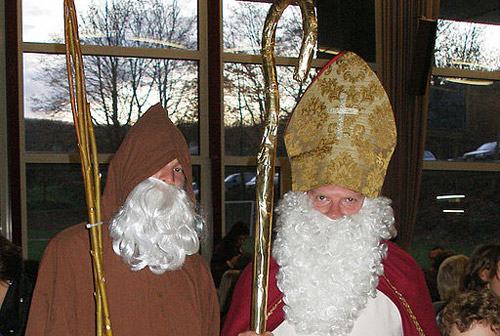
Not so much a monster as another thrasher of naughty children, Knecht Ruprecht is a sidekick of Saint Nicholas in German tradition. Varying versions of the story have Ruprecht leaving nuts or treats for good children, while leaving switches (for their parents to beat them with) for the bad. Still other versions cast him as more of a helper than a punisher. He’s usually depicted in dark robes and carrying a bundle of sticks. The similar character of Belsnickel appears in other traditions, and has many traits in common with Ruprecht.
3. La Befana
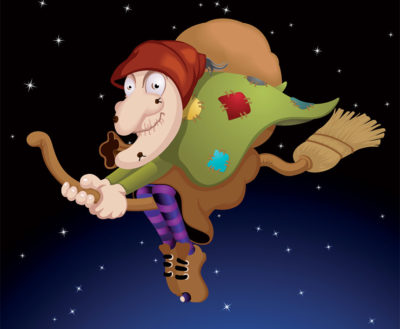
Sometimes called The Christmas Witch, Befana rises from Italian folklore to give gifts to kids on Epiphany Eve (January 5). Befana is said to fly on a broomstick and leave treats and presents in stockings, while leaving behind sticks or coal for bad children. Interestingly, while the story has been known for some time, the Befana traditions weren’t really subject to widespread practice in Italy until the 20th Century. Frau Perchta is a similar personage that may have been inspired by Norse myths; she fulfills the same function as Befana while alternately appearing as either a beautiful maiden or old woman (although she’s given to sometimes cutting open bad kids and stuffing them with straw).
4. Gryla, The Yule Lads, and The Yule Cat
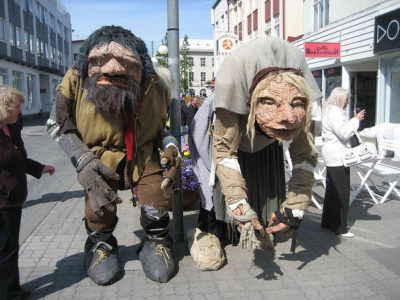
Iceland brings us one of the more elaborate Christmas monster mythologies, which stem from Yule lore. Grýla is a trollish giantess who lives in a cave with her large (and LARGE) family. There’s Jólakötturinn, the monstrous Yule Cat. There’s her lazy husband, Leppalúdi, who mostly doesn’t leave the cave. And there’s her 13 sons, the Jólasveinar, popularly known as the Yule Lads. On the whole, their reputation rests on their willingness to devour people, including children. Jólakötturinn, specializes in eating people who didn’t get new clothes before Christmas Eve (which ties back to a tradition of people getting new clothes as a reward for being good). Each of the Yule Lads has a particular prank or form of harassment associated with them that they perpetrate on the people, from stealing food to candles. Stories of the family go back centuries, but the 1932 poem Yule Lads by Icelandic poet and politician Jóhannes úr Kötlum set the canon for the names and behaviors of the Lads as they’re perceived today.
5. Père Fouettard
His name means Father Whipper in French, and he comes by it for good reason. Another companion of St. Nick, Fouettard is said to journey with the jolly man on Saint Nicholas Day and dole out beatings to the bad children while Nick rewards the good ones. Usually depicted with sticks and reeds, Fouettard is also described as frequently wearing a wicker basket on his back for the capturing of naughty children. He’s also traditionally shown as bearded, bedraggled, and dirty, as if having soot on this face. Unfortunately, the soot in recent years devolved in the use of blackface by cosplayers and parade-goers, stirring controversy in a manner similar to Zwarte Piet (Black Peter).
6. Zwarte Piet (Black Peter)
Black Peter first appeared in a Dutch book in 1850 and became a popular companion for Sinterklaas (aka Santa). In the book and later writings, the character is a Spanish Moor that becomes Sinterklaas’s assistant, occasionally punishing or even stealing naughty children. While it was quite common to see people don colorful costumes and blackface to depict Peter for many years, recent decades have seen a rise in controversy as various groups and celebrities have spoken against the practice. Some parades and programming have changed the appearance and the style of the character, while others doggedly adhere to what they see as tradition. Some communities and school corporations in Europe have taken to phasing the character out entirely.
7. Hans Trapp
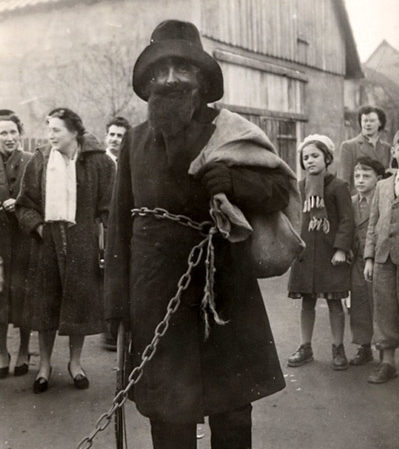
Almanach de Wintzenheim, Wikimedia Commons, GNU Free Documentation License, Creative Commons Attribution-Share Alike 3.0 Unported
Hans von Trotha was a real German knight in the 1400s. His story in folklore has become that of Hans Trapp. Over time, Trapp grew to be depicted as the “Black Knight” that stalked the Wasgau hills, frightening children and appearing in other legends. In the Alsace region (in northern France that borders Germany and Switzerland), Hans Trapp merged with the St. Nicholas story, replacing Knecht Ruprecht as Santa’s punisher.
8. Mari Lwyd
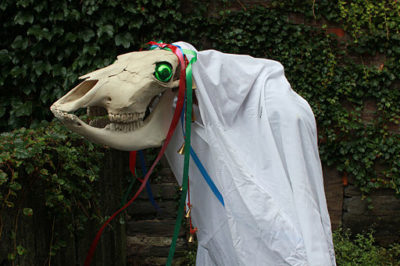
Yes, Virginia; there is a zombie horse of Christmas. This is a specific outgrowth of the wassailing tradition in Wales. In the States, we think of wassailing as simply caroling, but it’s more of a mix of caroling and trick-or-treating; in wassail, groups moves from home to home and sing in exchange for a drink (frequently, wassail itself, which is a hot mulled cider). In the Mari Lwyd tradition, one member of the group hoists a horse’s skull on a pole that is draped with a hood and leads the wassailers about. The Mari Lwyd group would sing and the home dwellers would respond in song; this went back in forth until the Mari Lwyd-bearers got their drink or moved on. The practice fell out of favor in the early 20th century, but experienced a revival before the year 2000. That year, Aberystwyth in Wales put together “The World’s Largest Mair Lwyd” for millennial celebrations.
Featured image: Nicola Simeoni / Shutterstock.com.
Become a Saturday Evening Post member and enjoy unlimited access. Subscribe now
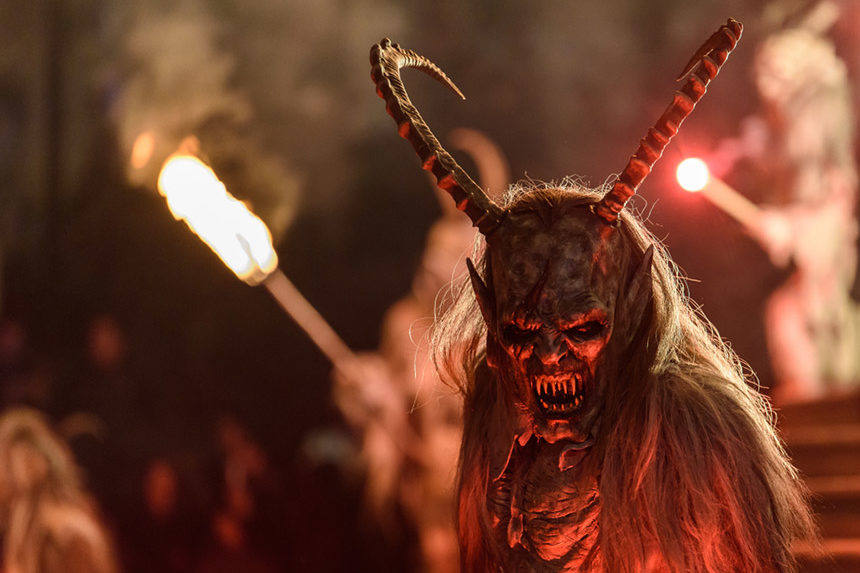



Comments
And don’t forget the worst Christmas monster of all: Hans Gruber! If you’ve been naughty, he and his minions break into your safe and steal your negotiable bearer bonds!